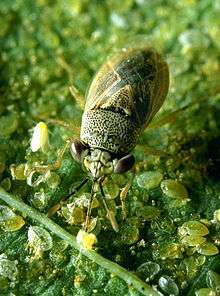Geocoris
Geocoris is a genus of insects in the family Geocoridae (although in the past the geocorids were subsumed as a subfamily under the family "Lygaeidae"). Commonly known as big-eyed bugs, the species in Geocoris are beneficial predators, but are often confused with the true chinch bug, which is a pest.[2][3] There are more than 140 described species in Geocoris.[1][4][5]
| Geocoris | |
|---|---|
 | |
| Geocoris punctipes | |
| Scientific classification | |
| Kingdom: | Animalia |
| Phylum: | Arthropoda |
| Class: | Insecta |
| Order: | Hemiptera |
| Family: | Geocoridae |
| Genus: | Geocoris Fallén, 1814 |
| Diversity | |
| More than 140 species | |
| Synonyms[1] | |
| |
Description
Big-eyed bugs are true bugs in the order Hemiptera. The two most common species are Geocoris pallens and Geocoris punctipes. Both are predators and occur in many habitats, including fields, gardens, and turf grass. Big-eyed bugs are considered an important predator in many agricultural systems and feed on mites, insect eggs, and small insects such as pink bollworm, cabbage loopers, and whiteflies. Adult big-eyed bugs are small (about 3 mm (0.12 in)) black, gray, or tan with proportionately large eyes. Eggs are deposited singly or in clusters on leaves near potential prey. They develop with incomplete metamorphosis (there is no pupa) and take approximately 30 days to develop from egg to adult depending on temperature. Both nymphs and adults are predatory, but can survive on nectar and honeydew when prey are scarce. Big-eyed bugs, like other true bugs, have piercing-sucking mouthparts and feed by stabbing their prey and sucking or lapping the juices. Although their effectiveness as predators is not well understood, studies have shown that nymphs can eat as many as 1600 spider mites before reaching adulthood, while adults have been reported consuming as many as 80 mites per day.[6][7]
Selected species
- Geocoris atricolor Montandon, 1908
- Geocoris bullatus (Say, 1832) (large big-eyed bug)
- Geocoris discopterus Stal, 1874
- Geocoris floridanus Blatchley, 1926 (Florida big-eyed bug)
- Geocoris frisoni Barber, 1926
- Geocoris howardi Montandon, 1908
- Geocoris limbatus Stal, 1874
- Geocoris pallens Stal, 1854 (western big-eyed bug)
- Geocoris punctipes (Say, 1832) (big-eye bug)
- Geocoris uliginosus (Say, 1832)
See also
References
| Wikimedia Commons has media related to Geocoris. |
- "Geocoris Report". Integrated Taxonomic Information System. Retrieved 2018-04-23.
- "Managing lawn and turf insects: blade-sucking: Predator: Big-eyed bug (Geocoris, Family Gelastocoridae, Order Hemiptera)". Extension Service, University of Minnesota. Archived from the original on 30 September 2013.
- Kastl, Herbert J. (1964). "Control of the Hairy Cinch Bug in Turf". Bulletin of the New York State Turfgrass Association. 73: 302.
- "Geocoris". GBIF. Retrieved 2018-04-23.
- "Geocoris Genus Information". BugGuide.net. Retrieved 2018-04-23.
- Schuh, Randall T.; Slater, James Alexander (1995). True Bugs of the World (Hemiptera: Heteroptera). Ithaca, New York: Cornell University Press. ISBN 978-0-8014-2066-5.
- Ashlock, P. D.; Slater, A. (1988). "Family Lygaeidae". In Henry, Thomas J.; Froeschner, Richard C. (eds.). Catalog of the Heteroptera, or True Bugs, of Canada and the Continental United States. Leiden, Netherlands: E. J. Brill. pp. 167–245. ISBN 978-0-916846-44-2.